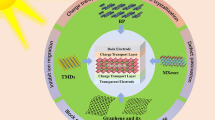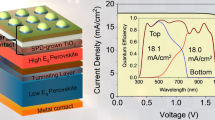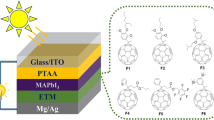Abstract
Conventional copper indium gallium diselenide (CIGS)-based solar cells offer higher efficiency than other second-generation technologies such as hydrogenated amorphous silicon (a-Si:H)- or cadmium telluride (CdTe)-based solar cells, but higher manufacturing cost due to the use of the rare metals indium and gallium. The purpose of the work presented herein is to improve the efficiency of such devices by using cheaper materials. Accordingly, a back-surface field layer made of low-cost and widely available barium silicide (BaSi2) with a thickness of 0.3 µm is introduced for the first time into the basic CIGS solar cell structure consisting of Al/ZnO/CdS/CIGS/Mo, resulting in the alternative structure of Al/FTO/CdS/CIGS/BaSi2/Mo, with fluorine-doped tin oxide (FTO) as the window layer. One-dimensional simulations of the solar cell capacitance are employed to study the photovoltaic parameters such as the power conversion efficiency, short-circuit current density, open-circuit voltage, fill factor, and quantum efficiency of the devices. The thickness of the CIGS absorber layer is varied from 0.1 to 3 µm to optimize the device. Besides, the effects of the acceptor ion and bulk defect densities in the CIGS absorber layer, cell resistances, and operating temperature on the overall performance are also investigated. The proposed structure offers an efficiency of 26.24% with a thin CIGS layer of only 0.8 µm. In addition to reduced CIGS thickness and cost, the presented approach results in CIGS solar cells with enhanced performance compared with previously reported conventional designs.










Similar content being viewed by others
References
Alhammadi, S., Park, H., Kim, W.K.: Optimization of intrinsic ZnO thickness in Cu(In, Ga)Se2-based thin film solar cells. Materials (2019). https://doi.org/10.3390/ma12091365
Bouich, A., Hartiti, B., Ullah, S., Ullah, H., Touhami, M.E., Santos, D.M.F., Mari, B.: Experimental, theoretical, and numerical simulation of the performance of CuInxGa(1–x)Se2-based solar cells. Optik (2019). https://doi.org/10.1016/j.ijleo.2019.02.067
Moon, M.M.A., Rahman, M.F., Hossain, J., Ismail, A.B.M.: Comparative study of the second generation a-Si:H, CdTe, and CIGS thin-film solar cells. Adv. Mater. Res. (2019). https://doi.org/10.4028/www.scientific.net/AMR.1154.102
Candelise, C., Spiers, J.F., Gross, R.J.K.: Materials availability for thin film (TF) PV technologies development: a real concern? Renew. Sustain. Energy Rev. (2011). https://doi.org/10.1016/j.rser.2011.06.012
Heriche, H., Rouabah, Z., Bouarissa, N.: New ultra thin CIGS structure solar cells using SCAPS simulation program. Int. J. Hydrogen Energy (2017). https://doi.org/10.1016/j.ijhydene.2017.02.099
Guirdjebaye, N., Ouédraogo, S., Ngoupo, A.T., Tcheum, G.L.M., Ndjaka, J.M.B.: Junction configurations and their impacts on Cu(In,Ga)Se2 based solar cells performances. Opto-Electron. Rev. (2019). https://doi.org/10.1016/j.opelre.2019.02.001
Oyedele, S.O., Soucase, B.M., Aka, B.: Numerical simulation and performance optimization of Cu(In,Ga)Se2 solar cells. IOSR J. Appl. Phys. (2016). https://doi.org/10.9790/4861-0804040111
Ando, Y., Ishizuka, S., Wang, S., Chen, J., Islam, M.M., Shibata, H., Akimoto, K., Sakurai, T.: Relationship between bandgap grading and carrier recombination for Cu(In,Ga)Se2-based solar cells. Jpn. J. Appl. Phys. (2018). https://doi.org/10.7567/JJAP.57.08RC08
Ramanathan, K., Contreras, M.A., Perkins, C.L., Asher, S., Hasoon, F.S., Keane, J., Young, D., Romero, M., Metzger, W., Noufi, R., Ward, J., Duda, A.: Properties of 19.2% efficiency ZnO/CdS/CuInGaSe2 thin-film solar cells. Prog. Photovolt. Res. Appl. (2003). https://doi.org/10.1002/pip.494
Repins, I., Contreras, M.A., Egaas, B., DeHart, C., Scharf, J., Perkins, C.L., To, B., Noufi, R.: 19.9%-efficient ZnO/CdS/CuInGaSe2 solar cell with 81.2% fill factor. Prog. Photovolt. Res. Appl. (2008). https://doi.org/10.1002/pip.822
Green, M.A., Hishikawa, Y., Dunlop, E.D., Levi, D.H., Hohl-Ebinger, J., Yoshita, M., Ho-Baillie, A.W.Y.: Solar cell efficiency tables (version 53). Prog. Photovolt. Res. Appl. (2019). https://doi.org/10.1002/pip.3102
Daoudia, A.K., Hassouani, Y.E., Benami, A.: Investigation of the effect of thickness, band gap and temperature on the efficiency of CIGS solar cells through SCAPS-1D. Int. J. Eng. Tech. Res. (IJETR) 6, 71–75 (2016)
Mostefaoui, M., Mazari, H., Khelifi, S., Bouraiou, A., Dabou, R.: Simulation of high efficiency CIGS solar cells with SCAPS-1D software. Energy Proc. (2015). https://doi.org/10.1016/j.egypro.2015.07.809
Robin, M.S.R., Mansoor, M., Rasmi, M., Sarkar, M.S.Z., Rabbi, A.S.M., Mamun, A.: Numerical modeling and analysis of ultra thin film Cu(In,Ga)Se2 solar cell using SCAPS-1D. In: International Conference on Electrical Engineering and Information and Communication Technology (iCEEiCT) (IEEE), 22–24th Sept. 2016, MIST, Dhaka, Bangladesh. https://doi.org/10.1109/CEEICT.2016.7873169
Benabbas, S., Rouabah, Z., Heriche, H., Chelali, N.: A numerical study of high efficiency ultra-thin CdS/CIGS solar cells. Afr. J. Sci. Technol. Innov. Dev. (2016). https://doi.org/10.1080/20421338.2015.1118929
Sylla, A., Touré, S., Vilcot, J.-P.: Numerical modeling and simulation of CIGS-based solar cells with ZnS buffer layer. Open J. Model. Simul. (2017). https://doi.org/10.4236/ojmsi.2017.54016
AlZoubi, T., Moustafa, M.: Numerical optimization of absorber and CdS buffer layers in CIGS solar cells using SCAPS. Int. J. Smart Grid Clean Energy (2019). https://doi.org/10.12720/sgce.8.3.291-298
Kohara, N., Nishiwaki, S., Hashimoto, Y., Negami, T., Wada, T.: Electrical properties of the Cu(In,Ga)Se2/MoSe2/Mo structure. Sol. Energy Mater. Sol. Cells (2001). https://doi.org/10.1016/S0927-0248(00)00283-X
Ahamed, E.M.K.I., Bhowmik, S., Matin, M.A., Amin, N.: Highly efficient ultra thin Cu(In,Ga)Se2 solar cell with tin Selenide BSF. In: 2017 International Conference on Electrical, Computer and Communication Engineering, February 16–18, 2017, Cox’s Bazar, Bangladesh. IEEE. https://doi.org/10.1109/ECACE.2017.7912942
Benabbas, S., Heriche, H., Rouabah, Z., Chelali, N.: Enhancing the efficiency of CIGS thin film solar cells by inserting novel back surface field (SnS) layer. In: 2014 North African Workshop on Dielectric Materials for Photovoltaic Systems, October 26–27, 2014, Algeria. IEEE. https://doi.org/10.1109/NAWDMPV.2014.6997611
Moon, M.M.A., Ali, M.H., Rahman, M.F., Kuddus, A., Hossain, J., Ismail, A.B.M.: Investigation of thin-film p-BaSi2/n-CdS heterostructure towards semiconducting silicide based high efficiency solar cell. Phys. Scr. (2019). https://doi.org/10.1088/1402-4896/ab49e8
Doorene, S.V.: Barium disilicide: Development of a novel, low cost and earth abundant absorber material for thin film solar cell applications. MS Thesis, Sustainable Energy Technology, Delft University of Technology, Delft, Netherlands, June 6, 2017. https://repository.tudelft.nl/islandora/object/uuid%3A177b86f2-cb70-4e74-b02b-b0ee421c7e36 (2017). Accessed 25 July 2019
Khan, M.A., Suemasu, T.: Donor and acceptor levels in impurity-doped semiconducting BaSi2 thin films for solar-cell application. Phys. Status Solidi A (2017). https://doi.org/10.1002/pssa.201700019
Deng, T., Sato, T., Xu, Z., Takabe, R., Yachi, S., Yamashita, Y., Toko, K., Suemasu, T.: p-BaSi2/n-Si heterojunction solar cells on Si(001) with conversion efficiency approaching 10%: comparison with Si(111). Appl. Phys. Express (2018). https://doi.org/10.7567/apex.11.062301
Suemasu, T., Usami, N.: Exploring the potential of semiconducting BaSi2 for thin-film solar cell applications. J. Phys. D Appl. Phys. (2017). https://doi.org/10.1088/1361-6463/50/2/023001
Kodalle, T., Choubrac, L., Arzel, L., Schlatmann, R., Barreau, N., Kaufmann, C.A.: Effects of KF and RbF post deposition treatments on the growth of the CdS buffer layer on CIGS thin films—a comparative study. Sol. Energy Mater. Sol. Cells (2019). https://doi.org/10.1016/j.solmat.2019.109997
Frisk, C., Platzer-Björkman, C., Olsson, J., Szaniawski, P., Wätjen, J.T., Fjällström, V., Salomé, P., Edoff, M.: Optimizing Ga-profiles for highly efficient Cu(In, Ga)Se2 thin film solar cells in simple and complex defect models. J. Phys. D Appl. Phys. (2014). https://doi.org/10.1088/0022-3727/47/48/485104
Burgelman, M., Decock, K., Niemegeers, A.,Verschraegen, J., Degrave, S.: SCAPS Manual (version: 3.3.07). Department of Electronics and Information Systems, University of Gent, Belgium. http://scaps.elis.ugent.be (2018). Accessed 5 January 2019
Dabbabi, S., Nasr, T.B., Kamoun, T.: CIGS solar cells for space applications: numerical simulation of the effect of traps created by high-energy electron and proton irradiation on the performance of solar cells. JOM (2018). https://doi.org/10.1007/s11837-018-2748-9
Huang, J., Lee, K., Tseng, Y.: Analysis of the high conversion efficiencies ß-FeSi2 and BaSi2 n-i-p thin film solar cells. J. Nanomater. (2014). https://doi.org/10.1155/2014/238291
Gloeckler, M.: Device physics of Cu(In, Ga)Se2 thin-film solar cells. Ph.D. dissertation, Colorado State University, Fort Collins (2005)
Nakada, T., Mizutani, M.: 18% efficiency Cd-free Cu(In,Ga)Se2 thin film solar cells fabricated using chemical bath deposition (CBD)-ZnS buffer layers. Jpn. J. Appl. Phys. (2002). https://doi.org/10.1143/JJAP.41.L165
Jackson, P., Wuerz, R., Hariskos, D., Lotter, E., Witte, W., Powalla, M.: Effects of heavy alkali elements in Cu(In, Ga)Se2 solar cells with efficiencies up to 22.6%. Phys. Status Solidi Rapid Res. Lett. (2016). https://doi.org/10.1002/pssr.201600199
Green, M.A., Dunlop, E.D., Levi, D.H., Hohl-Ebinger, J., Yoshita, M., Ho-Baillie, A.W.Y.: Solar cell efficiency tables (version 54). Prog. Photovolt. Res. Appl. (2019). https://doi.org/10.1002/pip.3171
Fridolin, T.N., Maurel, D.K.G., Ejuh, G.W., Bénédicte, T.T., Marie, N.J.: Highlighting some layers properties in performances optimization of CIGSe based solar cells: case of Cu(In, Ga)Se–ZnS. J. King Saud Univ. Sci (2018). https://doi.org/10.1016/j.jksus.2018.03.026
Yang, X., Chen, B., Chen, J., Zhang, Y., Liu, W., Sun, Y.: ZnS thin film functionalized as back surface field in Si solar cells. Mater. Sci. Semicond. Process. (2018). https://doi.org/10.1016/j.mssp.2017.08.011
Kaminski, A., Vandelle, B., Fave, A., Boyeaux, J.P., Nam, L.Q., Monna, R., Sarti, D., Laugier, A.: Aluminium BSF in silicon solar cells. Sol. Energ. Mater. Sol. Cells. (2002). https://doi.org/10.1016/S0927-0248(01)00185-4
Kuddus, A., Rahman, M.F., Ahmmed, S., Hossain, J., Ismail, A.B.M.: Role of facile synthesized V2O5 as hole transport layer for CdS/CdTe heterojunction solar cell: validation of simulation using experimental data. Superlattices Microstruct. (2019). https://doi.org/10.1016/j.spmi.2019.106168
Benzetta, A.H., Abderrezek, M., Djeghlal, M.E.: Contribution to improve the performances of Cu2ZnSnS4 thin-film solar cell via a back-surface field layer. Optik (2019). https://doi.org/10.1016/j.ijleo.2018.12.048
Sohid, S.B., Kabalan, A.: Numerical analysis of ZnTe based solar cell with Sb2Te3 back surface field layer using SCAPS-1D. In: 2018 IEEE 7th World Conference on Photovoltaic Energy Conversion, June 10–15, 2018, USA. IEEE. https://doi.org/10.1109/pvsc.2018.8547800
Paul, D.I.: Experimental characterisation of photovoltaic modules with cells connected in different configurations to address nonuniform illumination effect. J. Renew. Energy (2019). https://doi.org/10.1155/2019/5168259
Series Resistance. https://www.pveducation.org/pvcdrom/solar-cell-operation/series-resistance (2019). Accessed 15 July 2019
Omrani, M.K., Minbashi, M., Memarian, N., Kim, D.H.: Improve the performance of CZTSSe solar cells by applying a SnS BSF layer. Solid-State Electron. (2018). https://doi.org/10.1016/j.sse.2017.12.004
Acknowledgements
The authors would like to thank Marc Burgelman and his team at the Department of Electronics and Information Systems (ELIS), University of Gent, Belgium for providing the SCAPS software package, version 3.3.07.
Funding
This research did not receive any specific grants from funding agencies in the public, commercial, or not-for-profit sectors.
Author information
Authors and Affiliations
Corresponding author
Ethics declarations
Conflict of interest
The authors declare that they have no conflicts of interest.
Additional information
Publisher's Note
Springer Nature remains neutral with regard to jurisdictional claims in published maps and institutional affiliations.
Rights and permissions
About this article
Cite this article
Biplab, S.R.I., Ali, M.H., Moon, M.M.A. et al. Performance enhancement of CIGS-based solar cells by incorporating an ultrathin BaSi2 BSF layer. J Comput Electron 19, 342–352 (2020). https://doi.org/10.1007/s10825-019-01433-0
Published:
Issue Date:
DOI: https://doi.org/10.1007/s10825-019-01433-0




